How to Trim Your Hanging Plants and Baskets
By pruning overgrown leaves regularly, you not only encourage strong, healthy growth of your plants but also protect them from easily spreading disease problems. Your hanging plants will remain beautiful and look their best year after year.
In this actionable guide, we'll cover the basics of cutting your hanging baskets, determine the best time to complete the job, outline the basic tools you'll need for the job, and provide detailed messages to help you work effectively.


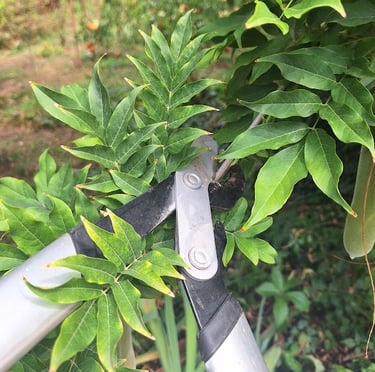

Key Takeaways
Importance of Pruning: Regularly trimming your hanging plants promotes healthy growth, prevents disease, and maintains an attractive appearance.
Best Time to Trim: Prune during the spring and summer for optimal results. Avoid pruning during the plant’s dormant period in winter.
Essential Tools: Use sharp pruning shears and scissors, and wear gloves for protection.
Step-by-Step Process:
Begin by thoroughly examining your hanging plant for any dead, yellowing, or diseased leaves and branches. Identifying these parts will guide your pruning.
Use pruning shears or scissors to cut away any dead or yellowing leaves, making sure to cut close to the base to avoid leaving stubs.
Trim any overly long stems that are reaching out in search of light. This encourages the plant to grow fuller and more compact.
Trim branches that are growing out of place or unevenly to create a balanced and aesthetically pleasing shape. This step enhances the overall look of your plant especially when you deal with shade plants.
Benefits of Regular Pruning
Regular pruning of hanging plants and hanging flowers offers several benefits:
Healthier Growth: Removing dead or diseased parts encourages new growth.
Disease Prevention: Pruning helps to remove any parts of the plant that may be susceptible to diseases, which is also a major benefit of deadheading perennials or other plants.
Improved Aesthetics: Well-trimmed plants look more attractive and vibrant.
Why Trimming is Important
Encourages Healthy Growth
Trimming helps to stimulate new growth by removing old, dead, or diseased parts of the plant. This makes room for new branches and leaves to develop, ensuring your plant remains lush and full.
Prevents Disease and Pest Infestation
Pruning your hanging plants regularly helps to prevent diseases and pest infestations. By removing unhealthy parts of the plant, you reduce the risk of these issues spreading to healthier areas.
Maintains Plant Shape and Appearance
Regular trimming helps to maintain the shape and appearance of your hanging plants. This is particularly important for hanging plants, which can become leggy and unkempt if not properly maintained.
When to Trim Hanging Plants
Spring and summer are the growing season for hanging plants and the best time to cut them.
Pruning during this time encourages new growth and helps keep the plant healthy and in good shape. However, it is important not to prune hanging plants during hibernation.
Pruning at this time will cause unnecessary stress to the plant because it is not actively growing and may have recovery problems after pruning.
It is best to wait until spring when the plants are actively growing to do any necessary pruning.
Signs That Your Plant Needs Trimming
Yellowing or dead leaves
Leggy growth
Reduced flowering
Overall unkempt appearance
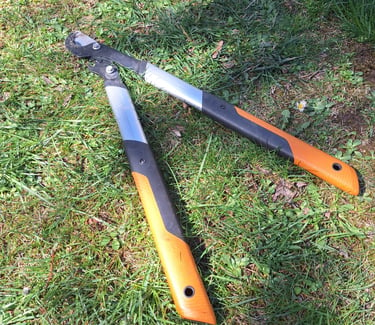

Tools Needed for Trimming
To trim your hanging plants, you’ll need the following tools:
Pruning Shears: For cutting through thicker stems and branches.
Scissors: For trimming smaller, delicate parts of the plant.
Gloves: To protect your hands from thorns and sap.
Choose tools that are sharp and well-maintained to ensure clean cuts. Dirty or dull tools can damage the plant and increase the risk of disease.
Trimming Your Hanging Plants in 5 Simple Steps
Step 1: Inspect Your Hanging Plant
Begin by thoroughly inspecting your hanging plant. Look for any dead, yellowing, or diseased leaves and branches.
Step 2: Remove Dead or Yellowing Leaves
Using your pruning shears or scissors, carefully cut away any dead or yellowing leaves. Make sure to cut close to the base of the leaf to prevent any stubs from remaining.
Step 3: Cut Back Leggy Growth
Leggy growth occurs when plants stretch out towards the light. Trim back any overly long stems to encourage fuller growth.
Step 4: Shape the Hanging Plant
Shape your plant by trimming it into a more balanced and aesthetically pleasing form. This might involve cutting back branches that are growing out of place or unevenly. For more detailed instructions on shaping plants, visit our article on how to care for them.
Step 5: Clean Up the Trimmings
Collect and dispose of all the trimmings to prevent the spread of disease. You can also compost the healthy trimmings if you have a compost pile.

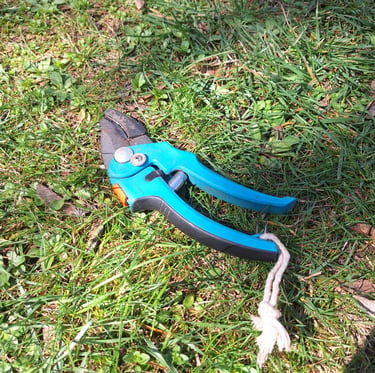



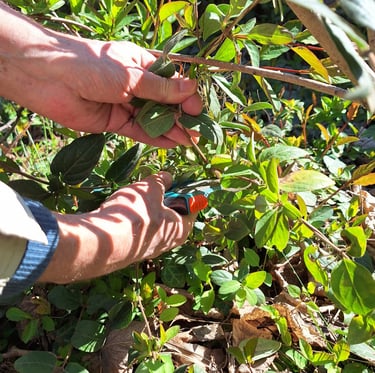


Deadheading a Hanging Plant in 4 Simple Steps
Step 1: Inspect the Plant
Carefully examine your hanging plant to identify any faded, wilted, or spent flowers. These are the flowers that need to be removed to encourage new blooms and maintain plant health.
Step 2: Choose Your Tools
Select a pair of sharp, clean scissors or pruning shears. Sharp tools ensure clean cuts, which help prevent plant damage and reduce the risk of disease.
Step 3: Position Your Cut
Locate the spent flower and trace its stem back to the first set of healthy leaves or buds. Make your cut just above this point. This helps redirect the plant’s energy to new growth rather than producing seeds, similar to pruning blueberry bushes.
Step 4: Make the Cut
With a steady hand, snip off the spent flower. Ensure you cut cleanly through the stem without crushing it, as a clean cut heals faster and better prevents disease entry.
Aftercare Tips
Proper Watering After Trimming
After trimming, water your hanging plant thoroughly to help it recover. Make sure the soil is evenly moist but not waterlogged.
Fertilization Tips
Consider feeding your plant with a balanced fertilizer to provide it with the nutrients it needs to regrow.
Monitoring for Any Signs of Stress
Keep an eye on your plant for a few days after trimming. Look for signs of stress such as wilting or yellowing leaves, and adjust your care routine as needed. For more aftercare tips, visit here.

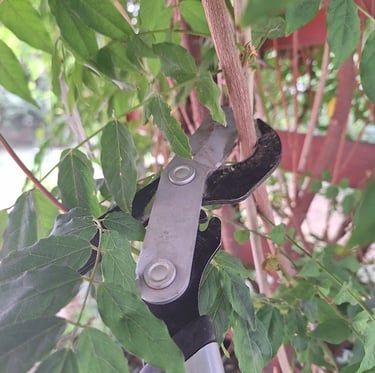




Frequently Asked Questions
How to keep hanging baskets from getting leggy?
To prevent hanging baskets from becoming leggy, ensure they receive adequate sunlight, as insufficient light often causes plants to stretch out.
Regular pruning and pinching back the tips of stems also encourage bushier growth. Additionally, rotate your hanging baskets periodically to ensure all sides receive even light exposure.
Where do you cut hanging plants?
When trimming hanging plants, cut just above a leaf node (the point where a leaf attaches to the stem) or above a healthy bud.
This encourages new growth and helps maintain a compact and attractive shape.
What to do when hanging plant gets too long?
If your hanging plant gets too long, trim back the overgrown stems to a manageable length. Cut back to just above a leaf node or bud to encourage new growth.
Additionally, consider repotting the plant if it has outgrown its container and ensure it receives proper light and nutrients to maintain healthy, balanced growth.
How often should I trim my hanging plants?
How often you need to prune hanging plants depends on the type of plant and how fast it grows. In general, pruning once or twice a year during the growing season (usually spring and summer) is sufficient. Regular pruning promotes healthy growth, prevents diseases, and maintains the plant's shape and appearance.
By removing dead or diseased parts and shaping the plant, you keep it lush and vibrant. Watching your plants and looking for signs such as yellowing or leggy leaves can help you determine when pruning is necessary to keep your plants on top.
Can I trim my hanging plants during the winter?
It is best not to prune hanging plants during hibernation. Pruning at this time will cause unnecessary stress to the plant because it may not grow well and may have problems healing.
Instead, wait until spring or summer during the growing season to prune hanging plants. Pruning during this time encourages new growth and helps keep the plant healthy and in good shape.
What should I do if my hanging plant looks leggy?
If your hanging plants seem to be getting too tall, prune back any overgrown stems to encourage fuller, more compact growth no matter if in shade or sun.
Leggy growth usually occurs when the plant reaches light, resulting in sparse, long stems. Use clean pruners or scissors to cut off long stems, preferably above the leaves, to encourage new growth.
Also make sure your plants get enough light, as insufficient light can cause leggy growth. Regular pruning and lighting will help your plants become healthier, more beautiful, more balanced, and more beautiful that's why trimming, pruning, and cutting back your hanging plants is super important although it doesn't seam like it.






Sources
Nature and Sustainability uses only high-quality sources, including peer-reviewed studies to support the facts we describe in our articles. Please read our editorial policy to learn more about how we keep our content accurate, reliable, and trustworthy.
Trimming hanging plants general information: Hanging basket - Wikipedia, Care for Hanging Plants (thespruce.com), Pruning Techniques (tamu.edu), How to Prune Houseplants (thespruce.com), Make a Hanging Basket (bhg.com)
Diseases when trimming: Managing Garden Diseases (wvu.edu)
Leggy plants and leaves: How to Fix Leggy Plants (bhg.com)
Choosing the right tools for trimming hanging plants: Choose The Right Tools (build-review.com)
Deadheading hanging plants: Deadheading | Gardening Know How
Share this article:
Day By Day Trends Team




Article By:
The Day By Day Trends Writer Team is dedicated to delivering the best insights on Health, Finance, Technology, Behavior, and Tourism. Our experts combine personal experience and research to provide you with informative and inspiring content.
Reviewed and Fact Checked By:


Calin is a gardening expert who knows a lot about gardening and plants. He is the founder of this website and is responsible for most of the content.

